ISSN ONLINE(2319-8753)PRINT(2347-6710)
ISSN ONLINE(2319-8753)PRINT(2347-6710)
P.R. Deepthi , R. Dhivyalakshmi1, K.Vijayakumaran Nair2
|
| Related article at Pubmed, Scholar Google |
Visit for more related articles at International Journal of Innovative Research in Science, Engineering and Technology
L-Alanine doped KDP crystals were grown from aqueous solution by natural evaporation method. The grown L-Alanine doped KDP crystals were characterized by UV-vis spectroscopy, FTIR spectroscopy powder X-ray diffraction studies and Second harmonic generation efficiency measurements. L-Alanine doped KDP crystals were found highly transparent and full faced. The experimental results evidence the suitability of the grown crystal for optoelectronic applications.
Keywords |
| UV-Vis spectroscopy, FTIR spectroscopy, powder X-ray diffraction studies. |
I. INTRODUCTION |
| Nonlinear optical materials possess wide range of applications in the field of telecommunication and optical information storage devices. The search for new and efficient NLO materials has resulted in the development of a new class of materials called semi organics. These materials have large nonlinearity, high resistance, too large induced damage, low angular sensitivity and good mechanical hardness [1–3]. Potassium dihydrogen phosphate (KDP) and its isomorphs are representatives of hydrogen bonded materials that possess important piezoelectric, ferroelectric, electrooptic and nonlinear properties. They have attracted interest of many theoretical and experimental researchers probably because of their comparatively simple structure and very fascinating properties associated with a hydrogen bond system involving a large isotopic effect, broad transparency range, a high laser damage threshold and relatively low production cost [4, 5]. The rapid growth of good quality crystals and various studies of organic and inorganic impurities doped KDP crystals have been reported by various investigators [6-16]. Improvement in the quality of KDP crystal and the performance of KDP based devices can be realized with suitable dopants such as transition metals, organic and inorganic dopants added in appropriate mol%. |
| In this paper an attempt has been made to grow large size optically transparent L-alanine doped KDP crystal by slow evaporation solution growth technique. The grown crystals were characterized by UV-VIS, PXRD and FT-IR analysis and NLO measurements. |
II. MATERIALS AND METHODS |
| L-alanine doped KDP crystals were grown using a good quality seed crystal at room temperature by solvent evaporation method. Analar grade reagent (AR) L- alanine and KDP were used. For the preparation of seed crystals, saturated solution of KDP was prepared first and then kept in a petri dish and allowed to grow seed crystals within 4 – 5days. The pH of the L-alanine doped KDP solution was found to be 3. The synthesized salt was again dissolved in double distilled water and then recrystallized by natural evaporation process. This process was repeated twice to improve the purity of the material. The growth period takes 25 days for bigger size. The grown crystals were found colourless and transparent. Figure 1 shows the photograph ofL-Alanine doped KDP crystals. |
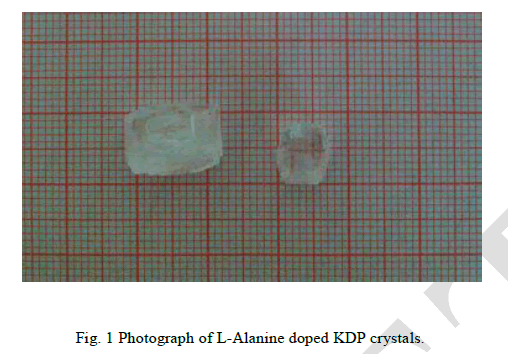 |
III. RESULTS AND DISCUSSION |
| UV-VIS SPECTRAL ANALYSIS |
| The optical transmission spectra of the grown crystal were carried out in the range of 200 nm to 2200 nm covering the entire near-ultraviolet, visible, and near infrared region using SHIMADZU UV-160 Spectrometer to find the transmission range about the suitability of this grown crystal for optical applications. An optically polished single crystal was used for this study. The UV transmission and absorption spectra for L-Alanine doped KDP are shown in Figure. 2(a) and 2 (b) respectively. A strong absorption and the UV cut off wavelength lies at 268 nm for L-Alanine doped KDP crystal, and it reveals the good optical quality of the grown crystal. High transmission in the entire visible region for L-Alanine doped KDP crystal proves the suitability of grown crystal as UV tunable laser and in second harmonic generation (SHG) device applications. The band gap calculated using the formula, Eg = hc/λ is found to be 4.63 eV. The absence of absorption and excellent transmission in entire visible region makes this crystal a good candidate for optoelectronic applications [17 – 19]. |
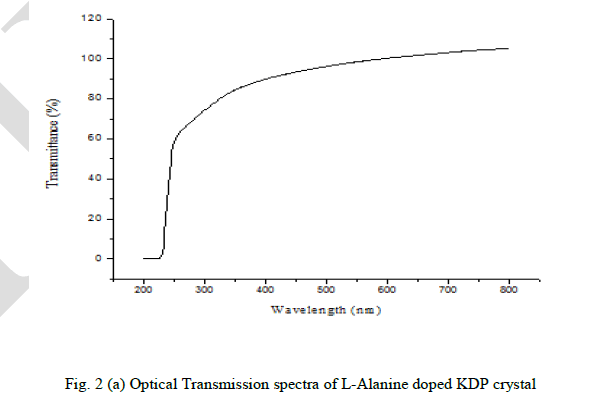 |
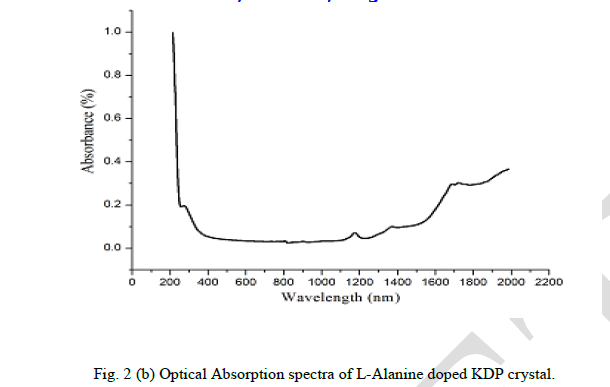 |
| The optical absorption coefficient (α) was calculated from the transmittance using the following relation, |
 |
| where ‘T’ is the transmittance, and ‘d’ is the thickness of the crystal. Owing to the direct band gap, the crystal under study has an absorption coefficient (α) obeying the following relation for high photon energies (ν) |
 |
| whereEg is the optical band gap of the crystal and A is a constant. The variation of (αhν)2vs (hν) is plotted and is shown in Figure 3. The band gap measured is found to be 5 eV, which indicates that the crystal has large photon absorption for second harmonic generation. |
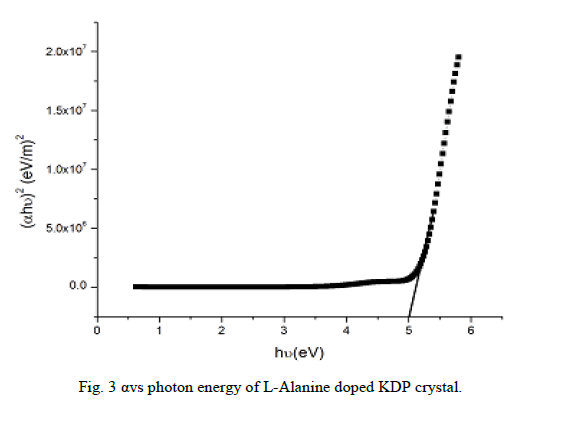 |
| POWDER X-RAY DIFFRACTION |
| X-ray diffraction technique is a powerful tool to analyse the crystalline nature of the materials. If the material to be investigated is crystalline, well defined peaks will be observed. Powder X-ray diffraction analysis was carried out by using PAN analytical X -Ray diffractometer with Cu Kα radiation. The sample was scanned over the range 20° - 80°. The XRD pattern obtained for the L-Alanine doped KDP crystal is shown in Figure 4. |
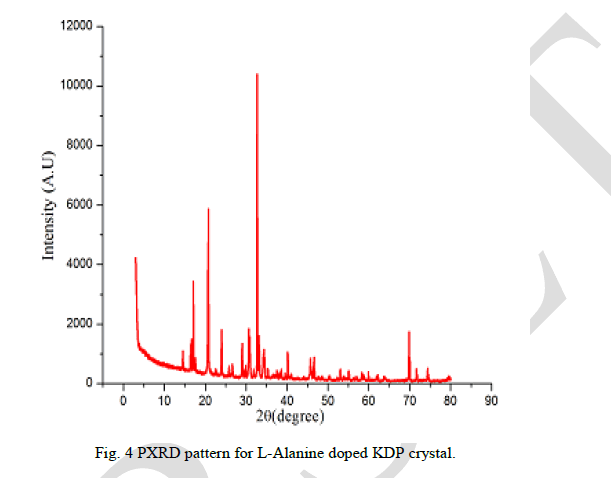 |
| FTIR SPECTRAL STUDY |
| The Infrared spectral analysis is effectively used to understand the chemical bonding and it provides information about the functional groups present in the synthesized compound. The FTIR spectra have been recorded in the range 400 to 4000 cm–1. The FTIR spectra of L-Alanine doped KDP is shown in Figure 5. The observed frequencies and their assignments for L-Alanine doped KDP crystal are listed in Table 1. |
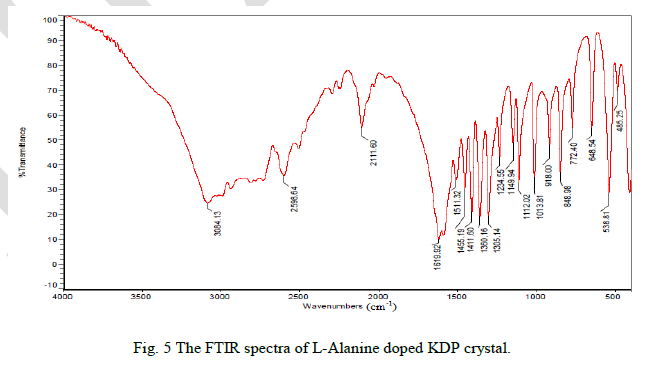 |
| Table1. Frequencies and their assignments for L-Alanine doped KDP crystal. |
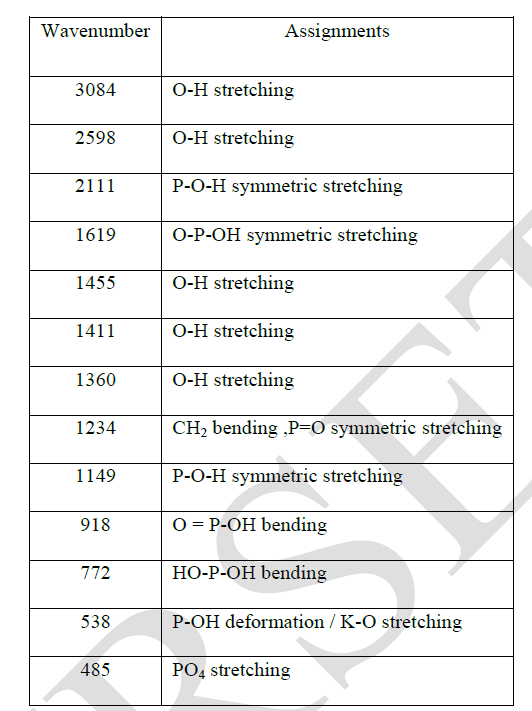 |
| SECOND HARMONIC GENERATION EFFICIENCY MEASUREMENTS |
| The first and the most widely used technique for confirming the SHG from prospective second order NLO materials is the Kurtz powder technique [20] toidentify the materials with non centrosymmetric crystal structures. The SHG conversion efficiency of L-Alanine doped KDP crystal was studied using a 1064 nm Nd:YAG laser. The schematic of the experimental set-up is shown in Figure. 6. The samples of LAKDP were made in powder form. To make relevant comparisons with known SHG materials, KDP was also ground and sieved into the same particle size range. The powdered samples were filled air-tight in separate micro-capillary tubes of uniform bore of about 1.5mm diameter. A Q-switched, A fundamental laser beam of 1064 nm wavelength from a Nd:YAG laser was made to fall normally on the sample cell. The power of the incident beam was measured as 4.4mJ/pulse. The input laser beam was allowed to pass through an IR reflector and then directed on the micro-crystalline powdered samples packed in a capillary tube. The photodiode detector and oscilloscope arrangements were measured the light emitted in the sample. The SHG radiations of 532nm (green light) emitted were collected by a photomultiplier tube (PMT-Hamamatsu-model R 2059). The optical signal incident on the PMT was converted into voltage output at the CRO (Tektronix-TDS 305213). |
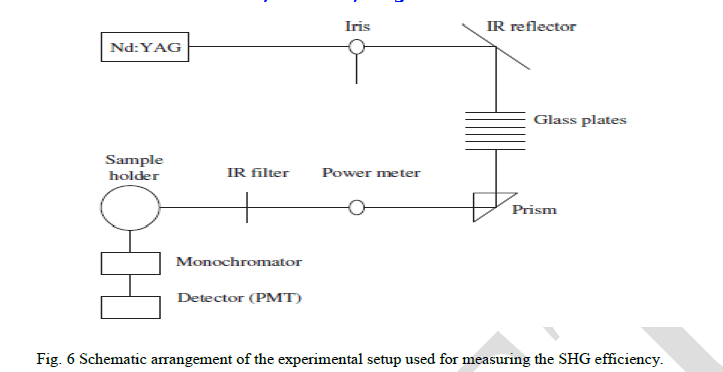 |
| Output intensity of SHG gives relative values of NLO efficiency of the material. It is found that the efficiency of SHG is58% of that of standard KDP. |
IV. CONCLUSION |
| Optically good quality crystals of L-Alanine doped KDP crystals have been grown by slow evaporation method. UVVis spectra showed that the grown crystal was optically transparent through 200-2200 nm and hence suggests the suitability of this material for optical devices. Powder X-ray diffraction analysis confirms the crystalline nature of grown crystal. The FTIR spectral analysis confirms the presence of functional groups in the crystals. The SHG test proves that thegrown crystals are potential candidate for nonlinear optical materials. The high optical transparency and micro hardness properties exhibit the optical quality and suitability of the as-grown KDP crystal doped with L-Alanine for optoelectronic device applications. |
ACKNOWLEDGEMENTS |
| The authors gratefully acknowledge the facilities offered by The Oxford College of Engineering, Bangalore, for doing this work and also place on record the support given by SAIF, Kochi, where the analyses were done. |